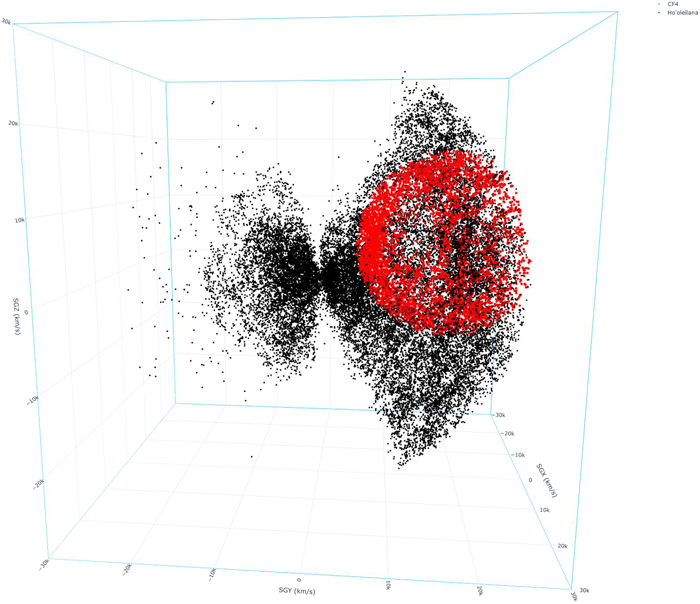
An interactive version of this figure is available on the COmputational ASTrophysics (COAST) website https://irfu.cea.fr/Projets/COAST/Ho'oleilana.html
The question of our place in the Universe - "where are we in the Universe?" - is a fascinating one, and the source of one of the oldest sciences: Cosmography, the mapping of the Cosmos. Using a method based on the study of the velocity fields of galaxies measured by different telescopes, cosmographers - a team of researchers from the CEA, the University of Hawaii and the University of Queensland - reconstruct the cosmic web of our nearby Universe and reveal its architecture, revealing large structures of superclusters of galaxies, but also large voids, shaped by gravitation [1].
Daniel Pomarède, from Irfu, has been in charge of mapping Cosmicflows catalogues and displaying them in 3D and interactively since 2010. Between 2014 and today, their catalogue has grown from 8,000 to 56,000 galaxies, and the map is expanding with the inclusion of a catalogue of galaxies measured by the SDSS collaboration [2].
With their latest Cosmicflows-4 catalogue, they have just discovered an immense bubble of galaxies, a new fossil from the beginnings of our Universe, dating from the same period as the cosmic microwave background radiation. This is the first time that a remnant of a wave, witness to the primordial universe, has been measured individually in the distribution of galaxies.
These results have just been published in The Astrophysical Journal.
“Ho’oleilana: An Individual Baryon Acoustic Oscillation?” by R. Brent Tully, Cullan Howlett, and Daniel Pomarède, The Astrophysical Journal, Volume 954, Number 2 https://doi.org/10.3847/1538-4357/aceaf3
Artistic view of Ho'oleilana (here in HD).
The three-dimensional shell surrounded by the acoustic oscillation of the baryons is coloured brown. Its rendering is intensified to highlight its galaxy content and its 'place' in the wider structure of the cosmic web. The positions of the galaxies, represented by tiny points of light, are taken from the Cosmicflows-4 catalogue, while the cosmic web, represented by the bluish filamentary structure, is taken from a preliminary analysis of the density field deduced from the same catalogue. The distribution of galaxies and the cosmic web are extrapolated beyond the range of our current measurements to complete the image. In addition to Ho'oleilana, this view also shows the structures discovered in recent years by the Cosmicflows research programme: Laniakea, the supercluster of galaxies that includes our own Milky Way galaxy; the South Pole Wall, a giant filament of the cosmic web that embraces the southernmost borders of Laniakea; the Dipole Repeller and the Cold Spot Repeller, two under-dense regions that are likely to be associated with two giant cosmic voids.
Credits: Frédéric Durillon, Animea Studio; Daniel Pomarède, IRFU, CEA Université Paris-Saclay. This work has received government funding from France 2030 (P2I - Ecole doctorale de physique) under reference ANR-11-IDEX-0003."
This entity has been given the name Ho'oleilana, a term derived from the Hawaiian creation song Kumulipo, which evokes the origin of the world.
It takes the form of a spherical shell containing superclusters of known galaxies (see figure above). This would be the first observation of the imprint left by a BAO (Baryon Acoustic Oscillation) acoustic wave [3]. These oscillations originate in the opposition between gravitation and plasma pressure, two antagonistic phenomena that are exacerbated in regions of higher density, such as that identified in the Boötes Supercluster at the centre of Ho'oleilana. Its diameter measures one billion light-years, and its centre is 820 million light-years from us. It is the expected size of a BAO that would have grown with the expansion of the Universe since the moment when the wave was frozen, when the first hydrogen atoms were formed 380,000 years after the Big Bang.
This is the first time that the remnants of one of these waves, witnesses of the primordial universe, have been measured individually in the distribution of galaxies. Until now, BAOs have only been observed indirectly in the statistical study of the spatial distribution of galaxies or other tracers, making it possible to measure the parameters of the standard model of cosmology, such as the Hubble constant, the curvature of the universe or dark energy.
By comparing their results with simulations, the researchers demonstrated that the shell structure identified as Ho'oleilana has less than a 1% probability of being a chance alignment. Ho'oleilana has the geometric properties of an acoustic baryon oscillation predicted by theory, including the prominence at its centre of a rich supercluster, but it stands out stronger than expected. Ho'oleilana is slightly larger than expected and the Hubble constant that can be deduced from its size is in agreement with measurements in the local Universe (supernovae, Cepheids, etc.) and in tension with measurements made in the distant Universe (Planck with the CMB, SDSS and quasars, etc.).
Future more detailed data, such as that from the Dark Energy Spectroscopic Instrument (DESI) or the 4MOST Hemisphere Survey, could enable similar structures to be detected elsewhere in the near Universe. Researchers will use these data to study and confirm other details about Ho'oleilana, BAO and the expansion rate of the Universe.
other links to this news:
[1] previous highlight on Cosmicflow catalogues :
[2] SDSS Peculiar Velocity (SDSS PV) catalog (Howlett, C., et al. 2022, MNRAS, 515, 953, https://doi.org/10.1093/mnras/stac1681
[3] Ho'oleilana: An ScienceIndividual Baryon Acoustic Oscillation?
The Astrophysical Journal, Volume 954, Number 2
[4] Interactive visualisations and video of the article:
• Structure and evolution of the Universe › Evolution of the large structures and galaxies
• Institute of Research into the Fundamental Laws of the Universe • The Electronics, Detectors and Computing Division
